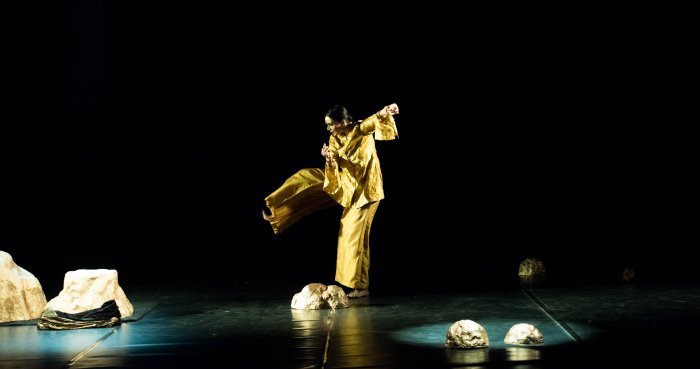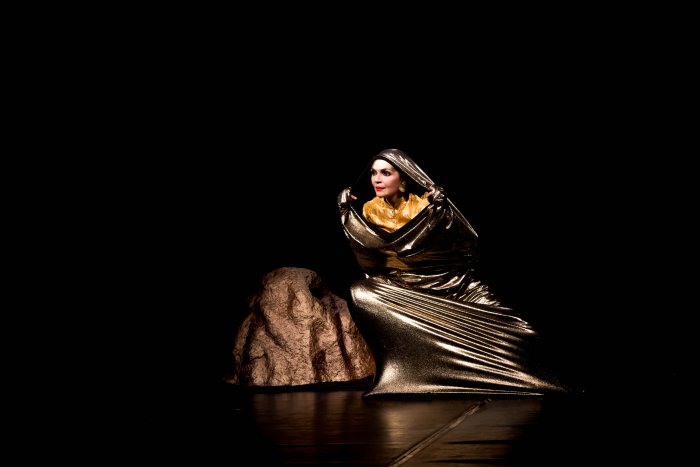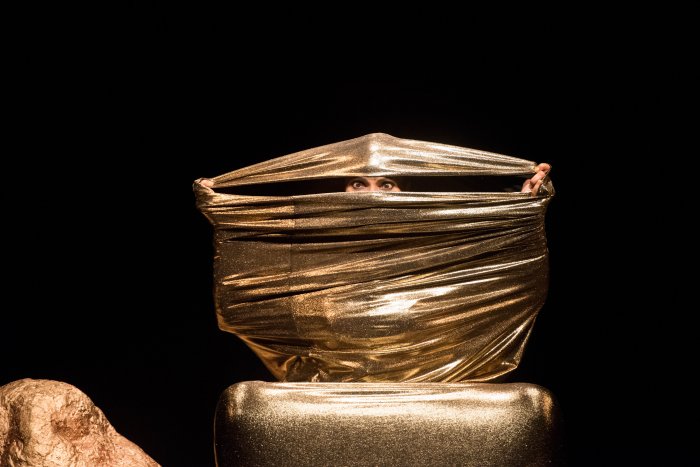STONE (2017)
Concept Note
Her birth and marriage were not her decisions. Her life was prescribed
by loneliness and solitude. For the one decision she made as a woman,
she was shamed into a numbing silence, lawless beauty, discarded wife,
shunned woman. AHalya represents the many facets of her gender through
centuries of misinterpretation and misogyny. Her enigma endures...her
unfinished tale waits to be retold. A performance by Anita Ratnam.

Credits
Co Choreography and performance: Anita Ratnam
Choreography: Hari Krishnan
Costume and Visual design: Rex
Lighting and Sets: Victor Paulraj
Sound Design: Vedanth Bharadwaj at SAMA studios
Calendar of performances:
Aug 29, 2020: STONE... once again - Digital: Jomba 2020, South Africa (jomba.ukzn.ac.za)
Jan 19, 2018: STONE.. - SNA Akademi Puraskar 2017 - Meghdoot Theatre, New Delhi
Jan 2, 2018: AH SU RA - Spaces, Besant Nagar, Chennai
Dec 30, 2017: AH SU RA - Gratitude Heritage, 52 Romain Roland St, Pondycherry
Dec 28, 2017: AH SU RA - Sri Krishna Gana Sabha, Chennai
 
'STONE...ONCE AGAIN'
Reviews/Responses
to the performance at Digital: Jomba 2020
*
The tactics seem to reside in the space in between, in the openings that
split the rock, where the golden lava twists out and the fist gestures
openings.
As Anita Ratnam reworks an Indian epic myth, and contemporises the
plight of woman, it is an old, and ancient story that she re-moves. Her
voice-over evokes (re)iterations and brings to mind similar myths from
other (feminist) traditions: Galathea loosened from Pygmalion's rock in a
reverse construction of haptic sensitivity that Marie Sallé grasped so
coherently in her 1734 choreographed 20 minute performance, uncorseted,
without wig or mask, casting 18th century pantomimic vocabulary onto an
ancient Greek sculpture; or Medusa's petrifying look; and (perhaps)
the 20thcentury anti-apartheid slogan of the women's Black
Sash movement "Strike a woman, strike a rock".
Her stone is paradoxically powerfully self-expressive - like the veil of
the Algerian women that takes on the coloniser - almost translucent and
transfigurative, as if washing over the river's pebble bed; and then
stretchy, figurative, splitting into Medusa's wide smile before
returning the gaze. There is no Cixousian laugh, and yet the rock pounds
the rock as if incarnating Emmanuel Dongala's Congolese rock-breaking
women who demand a fair price for their sack of gravel, or with a twist
on Sisyphus, the rocks she lifts before her are those of woman's
imprisonment.
Conceiving of feminist intersectionality, Stone...again stretches in
deep pliés into legendary history to bring into the 21st century, an
engagéed embodied female. Performing on the diagonal-incline women's
coming-to-agency across time-space-myths, firmly grounded without the
hesitation of the traditional Bharatanatyam foot's rhythmic beat,
and with hands that flatly refuse the semiotics of mudras, Stone...again
tactically alchemises the stone of lamentation into golden vital lava,
in its affirmation of woman's own pleated, circular movements against
the rigidity of imprisonment's injustice.
- Sarah Davies Cordova, Professor of French, Italian, and Comparative Literautre, University of Wisconsin-Milwaukee
*
Dancing stories during lockdown
- Prof. Ketu H Katrak (Guest writer), Dancing Digitally
*
Goddess, on stage and screen
- Kamini Govender (Guest writer), Dancing Digitally
*
Ratnam speaks truth to power
- Cameron S Govender, Dancing Digitally
*
Anita Ratnam's performance Stone is engaging and beautiful, entrancing.
She does many things in this performance. Not only is she presenting the
still universal issues of women's sense of being trapped within
society's rules through her constraints created by the beautiful
textiles she is wrapped in, but she is also evoking the animating
lifeforce of the land, springs and rocks that many indigenous people
believe in, by being in a rock. And yet, amongst the music there was a
steady, quiet but relentless presence of a hammer, chipping away at some
bedrock, slowly breaking rock, releasing the stone's soul, yet she
remains within it, but eventually is released. This hammering was
not calming, but increasingly built a worrying tension.
As woman's power is slowly trying to come out of the rock, nearby
someone is breaking up rock, as if she has to deal with her own rage of
entrapment as well as the rage of being broken at the same time, while
being released. By the time she is released from the rock, she is the
spirit of the rock now materialized, with the strength and the power of
that rock in human form, stopping past aggression and encapsulating the
power of rock of the earth and of life itself. This is an elegant
and evocative depiction of the power of the landscape merged with female
power, unstoppable.
- Christine Hastorf, University of California, Berkley
*
In "STONE...Once Again," Anita Ratnam transforms the plain purple jersey
garment that held Martha Graham's mourning in her signature 1930 piece,
"Lamentation" into a scintillating, reflective golden garment that
announces not sorrow but transformation from bondage to
liberation. Anita's work declares it time for Indian women to
emerge and claim the full power of self-determination and speech.
Most effective for me was the opening segment when, breaking away from
Graham's tightly enclosing stretchy fabric, Anita's "Ahalya" gently
folds and unfolds herself beneath a sheer metallic almost tent-like
veil. Here, under the revealing and concealing gold, her long open
arms and fingers both supplicate and invite, then wrap her in the
comfort of self-embrace like a single-celled being. Equally potent
was the moment when fingers, then red lips, then eyes and a full face
later break through the more restrictive stretch garment. It is a
delight to see this stunning prima of India's dance world continue to
evolve in wisdom and beauty.
- Deidre Sklar, PhD, Guild Certified Feldenkrais Practitioner ® , Carpinteria, CA
*
I recently had the pleasure of watching excerpts from Anita Ratnam's
Ma3Ka, a piece I have been hoping to catch on the shores of South Africa
at Jomba! this year. Having to watch this share on the digital platform
however did not take away from Ratnam's sheer brilliance! In Ma3Ka, as
with most of her work, Ratnam's women always deviate from the accepted
and expected norms of womanhood, in this case predominantly,
Indian/Hindu womanhood. The bold use of her style, Neo-Bharatam, the
beautifully woven soundscape and her pointed humour always adds a layer
of disruption to both classical dance and also the mythologies that she
carefully rewrites and makes present in the contemporary. As always,
Ratnam's costume and set perform with and through her. An example of
this is how Lakshmi's braid becomes her co-performer and at times
suffocates or releases her.
In STONE, Ratnam's use of the metallic cocoon and the haunting
soundscape were enough for me to conjure up many thoughts and feeling in
my mind and body. The voice over, unnecessary, led the work in a
particular direction. However, this did no draw away from the haunting
power of the woman's body caught in this chamber, pushing and pulling
against it, eventually screaming through and emerging as if
birthed as an emancipated woman. Ratnam's Ahalya speaks to the
contemporary in ways that conjure up the darknesses of gender based
violence (what I call the real pandemic of our time), that is both
particular to the Indian and South African context - and to the context
of being and surviving contemporary womanhood. In this way, Ahalya moves
beyond her originating story in Ramayana, but still allows for the
metaphors of stone to be tied to the original narrative, of always being
forced and policed by the hands of a men, this time however, Ahalya
seems to free herself, no longer in waiting for the releasing touch of
yet another man!
The works are fresh, funny, haunting, beautiful, emancipatory and even
present the possibilities of birthing, of new ways of being and enacting
the feminine, the goddess, the woman!
- Reshma Chhiba, Creative Director, Sarvavidya Natyaalaya
*
Anita Ratnam's creative and innovative work as a performing artist was
deeply moving at the JOMBA! Digital Dance Festival (Aug-Sept 2020) in
Durban, South Africa. Ratnam's work Stone paid tribute to the power and
energy that resides in women, despite spoken and unspoken patriarchal
controls. Selecting stories of our most revered goddesses, like Lakshmi,
Saraswati and Meenakshi, Ratnam recreated the ferocity and resilience
of women's inner strength. I was struck, particularly by Ratnam's use of
the golden, metallic-like fabric that enveloped Ahalya, the beautiful,
flawless woman, married to the ascetic Gautama who expressed no human
passion towards her. When approached by Lord Indra, however, Ahalya
breaks free of her imprisonment and expresses deep desire for her lover.
For this, Gautama curses her to live like a stone, without feeling. The
shifting emotions of despair, struggle, and desire were conveyed by the
brilliant choice of the plasticity of the material covering Ratnam's
body. Every move was poignant. The grace and beauty of every single
movement of breaking out of confinement, was like a butterfly emerging
from the chrysalis, when Ratnam's beautiful face and elegant body
emerged.
- Beheroze Shroff, documentary filmmaker
Responses to AH SU RA
Home | About | Events | Active Repertoire |
Activities | Press | Contact | Site map
|










